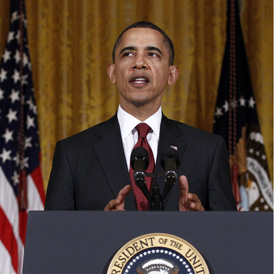Libya: Europe’s Vietnam?
As the battle for Benghazi intensifies defence analyst Anthony Tucker-Jones writes for Channel 4 News on NATO’s immediate military options, following the UN’s Libyan No-Fly-Zone.

After the announcement of UN Security Resolution 1973 on 17 March, it was perhaps hardly surprising that Gaddafi’s regime offered immediate compliance with the call for a ceasefire in order “to protect civilians”.
His media management in recent weeks has become more sophisticated and his representatives have made it look like they are part of the UN process not the problem.
For once this UNSCR seems to cover every eventuality. Key amongst its stipulations are an immediate ceasefire; that civilians and civilian populated areas be protected, a ban on all flights (except humanitarian) within Libyan airspace and the authorisation of ‘all necessary measures to enforce compliance’ and finally the strict implementation of an arms embargo including mercenaries.
Prime Minister David Cameron in his statement to Parliament on 18 March said: “The Defence Secretary and I have now instructed the Chief of the Defence Staff to work urgently with our allies to put in place the appropriate military measures to enforce the Resolution – including a No-Fly Zone.”
We are now likely to see Libya divided up into a series of ‘engagement zones’ better known as ‘kill boxes’.
To this end the RAF’s Tornado and Typhoon aircraft are now deploying to bases nearer Libya. The Tornado GR4s are based at RAF Lossiemouth and RAF Marham, while the Typhoons are at Coningsby and Leuchars. These are likely to operate from southern Italy or France, or at a stretch RAF Akrotiri in Cyprus (though this is a bit of a long haul).
Malta has also been mooted as a possible FOB or Forward Operating Base, but this may be problematic for the Maltese who have enjoyed close relations with Gaddafi’s Libya over the years. Arab League states may also provide basing facilities and aircraft.
During the Balkans conflict key NATO operating bases were in Germany at Ramstein and Rhein-Main, with smaller ones at Geilenkirken and Spangdahelm. Carriers were also provided by America, Britain and France to patrol the Adriatic.
Read more: Who armed Gaddafi?
However, this time round with Germany wishing to avoid direct military involvement, any NATO assets committed to the No-Fly Zone over Libya will be reliant on Italian airbases such as Amendola, Brindisi and Istrana.
In the 1990s the Combined Air Operations Centre for the 5th Allied Tactical Air Force operated out of Dal Molin airbase, Vicenza, Italy. While aircraft of several Allied forces flew as part of the combined strike packages in the Balkans, cooperating with any Arab contingents committed to the Libyan No-Fly Zone will prove difficult.

Crucially the imposition of a broad based No-Fly Zone has thrown the Libyan opposition and the Transitional National Libyan Council a much needed life line. The most immediate impact of UNSCR 1973 is to safeguard the people of Misrata and Ajdabiya, who had been under mounting attack in recent days.
How long Gaddafi chooses to be compliant remains to be seen, previously he chose to ignore UNSCR 1970 which called for a halt to the violence against the Libyan people. Certainly the British Government was anticipating ‘a brutal attack using air, land and seas forces’ by Gaddafi on Benghazi, a city of a million people.
We are now likely to see Libya divided up into a series of ‘engagement zones’ better known as ‘kill boxes’. These will be patrolled by an airborne forward air control aircraft, which will call in strike aircraft to respond to any violations. UAVS and cruise missiles could also play a role. This tactic was used with mixed results in Kosovo.
From the early to late 1990s NATO air forces were involved continuously in Balkan operations. NATO and UN airpower was deployed in every type of air operation from strategic bombing to air-to-air combat, so there is a wealth of experience to draw on.
Gaddafi’s command and control communications network may have to be silenced.
Imposing a one hundred per cent effective No-Fly Zone will be difficult. Key players are likely to be NATO’s tried and tested E-3 AWACS airborne early warning force. If Gaddafi is non-compliant, safeguarding the patrolling aircraft will require aggressive SEAD or suppression of enemy air defences operations.
Potential targets subject to the Libyan No-Fly Zone as well as airbases and air defence sites will include naval facilities, communication hubs and ground forces. The Libyan air force base outside Tripoli could be a key target in the same way that Batajnica near Belgrade, Serbia was during the Balkans conflict.
Similarly Gaddafi’s command and control communications network may have to be silenced. Serb communications in western Bosnia were disrupted by missile attacks on the Lisna communications mast and radar site. The first cruise missile strikes damaged, but did not put out of action the Yugoslav air defences, which led to problems.
While the opening shot has been fired across Gaddafi’s bows, the UN remembers how the Balkan’s were dubbed ‘Europe’s Vietnam.’ Clearly NATO is keen to ensure that Libya does not gain this same sobriquet, so the commitment of ground forces remains for the moment at least firmly off the agenda.
Anthony Tucker-Jones is author of “The Rise of Militant Islam.”